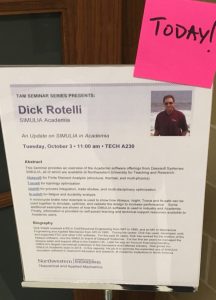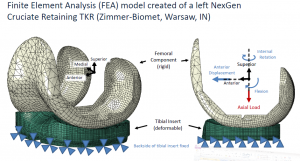
The best part of working on the SIMULIA Academic Team is visiting our academic customers. Seeing the innovative ways they are employing the SIMULIA product portfolio, is inspiring. Recently, I made a trip to the Chicago area to visit Northwestern University and Rush University Medical Center.
Northwestern University is a long-time SIMULIA academic customer with a research license used by the departments of Mechanical Engineering, Civil Engineering, and Material Science. I met with several NU professors who lead research teams focused on advanced material modeling, multi-scale simulations, and additive manufacturing applications, including Profs. Jian Cao, David Dunand, and Cate Brinson*.
While Abaqus is the primary SIMULIA product used in research, I was pleased to see they are leveraging other programs within the SIMULIA Academic Suite including Isight and Tosca. During a meeting with Prof. Wei Chen, I learned how she is using Isight in her Design Optimization course, and explained how we can improve her students’ access to Isight via the SIMULIA Academic Teaching license.
Additionally I met with Prof. Yonggang Huang, keynote speaker at Science in the Age of Experience and featured customer in the May 2016 SIMULIA Community News magazine, to discuss his ground-breaking research on stretchable electronics. An interesting side note about Dr. Huang: His mother founded the first Abaqus sales and support office in China in the late ‘90s which, incidentally, was just around the time that I founded the Abaqus office in the Northeast US.
Thanks to Dr. Huang, I had the pleasure of presenting a SIMULIA overview lecture to a large group of faculty and graduate students as part of the Theoretical and Applied Mechanics Seminar Series. This lecture focused on industry examples highlighting how the SIMULIA Portfolio, (Abaqus, Isight, Tosca, and fe-safe) can enable simulation engineers to move beyond validation to innovation.
Rush University Medical Center is a relatively new SIMULIA Academic customer comprised of a small group of researchers led by Prof. Hannah Lundberg. While visiting, I had the opportunity to engage in some very interesting technical discussions with PhD student Steven Mell and Post-Doc researcher Jonathan Gustafson. Steven successfully used Isight and Abaqus to better understand wear in Total Knee Replacements (TKRs) and published his work at the 2017 Science in the Age of Experience event.

Jonathan is a recent addition to the Rush research team and is now embarking on a study of fretting fatigue and wear in Total Hip Replacement modular taper junctions. By building off the success Steven has had analyzing TKRs he plans to use Isight to execute and manage large-scale parametric studies on Abaqus finite element models. This will allow him to quantify the effect of a multitude of geometric, material, and loading parameters on wear performance at the taper junctions.
My trip to Chicago and visiting with the research teams from Northwestern University and Rush University Medical Center was invaluable. I can’t emphasize enough how rewarding it is to spend time with our customers. I’d like to give a big thank you to Northwestern University and Rush University Medical Center for sharing their incredible time and work with me!
The SIMULIA Academic Team can be reached at SIMULIA.NAM.Academic@3ds.com.
*Dr. Brinson is moving her research team to Duke University. We hope to publish an article on her team’s work in the future.
